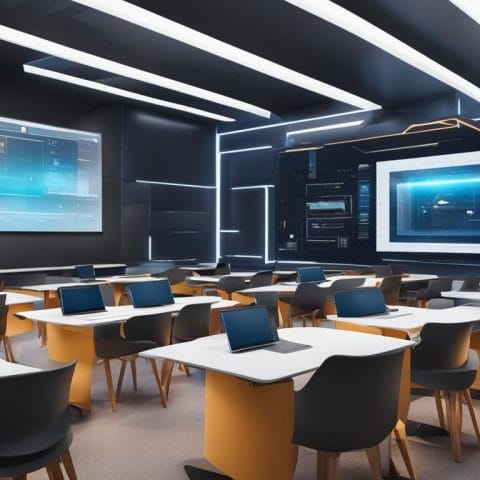Virtual reality (VR) is changing corporate training in big ways. It offers immersive, interactive, and flexible learning experiences. This is making a huge difference in how companies train their teams.
This report will explore why VR is making corporate training better. We’ll look at five common challenges and how VR solves them. We’ll see how VR can create realistic environments, improve motor skills, and allow training anywhere, anytime.
The Business case for virtual reality in training is strong. VR training simulations make learning more engaging and help keep knowledge longer. They also save money and offer safe practice spaces. By using VR training simulations, companies can grow their training, get valuable data, and teach in many ways, even remotely.
Key Takeaways
- VR offers immersive, interactive, and versatile learning experiences that revolutionize corporate training.
- VR training simulations provide cost-effective solutions and risk-free practice environments.
- VR enhances knowledge retention and enables scalable training deployment with data-driven insights.
- VR delivers engaging multimedia instruction, even in remote collaborative training settings.
- VR addresses traditional training challenges by incorporating realistic environments and enabling anytime, anywhere training.
The Transformative Potential of VR in Corporate Training

Virtual reality (VR) is changing corporate training, offering deep learning experiences. It goes beyond old ways of training. With realistic simulations and safe practice areas, VR training is a standout. It boosts skill development and gets employees ready for real challenges.
Enhanced Realism and Interactivity
VR training brings unmatched realism and interactivity. It lets trainees dive into scenarios that feel like real life. This hands-on method helps employees practice complex tasks and improve their skills in a safe space. It boosts their confidence and skill level.
Safety in High-Risk Training Environments
VR provides a safe space for training in risky situations, like emergencies and stress management. It lets employees practice making critical decisions and develop muscle memory safely. This prepares them well for real emergencies.
“VR training allows employees to practice high-stakes and safety procedures without risks, offering a safer and cost-effective alternative to traditional methods.”
– Chris Gunby
VR’s power in corporate training is in its ability to create immersive, interactive, and safe spaces. These environments are perfect for hands-on skill development and emergency response training. As more companies use VR, corporate training will become more engaging, effective, and impactful.
Overcoming Traditional Training Challenges with VR

Traditional training often lacks the realism and interactivity needed for real-world scenarios. Lack of training realism and passive learning experiences can lead to a gap between training and job challenges. Also, logistical constraints and accessibility barriers in traditional programs limit their reach, especially for remote workforces.
Virtual reality (VR) offers a solution to these challenges. It immerses trainees in realistic and interactive environments. This bridges the gap between theory and practice. VR also allows employees to learn anytime, anywhere, overcoming time and location barriers.
Breaking Down Barriers to Effective Training
PwC research shows VR training can be up to four times faster than traditional classroom training. For example, Walmart reduced a 30- to 45-minute training session to just 3- to 5-minute VR simulation. VR training also reached cost parity with in-person training at 375 learners, saving a lot of money.
Accessibility is key, as up to 1 in 4 adults in the United States have some form of disability. VR solutions must be inclusive and adaptable for disabilities. VR’s flexibility helps organizations reach more people with their training programs.
| Benefit | Impact |
|---|---|
| Increased Training Effectiveness |
|
| Cost-Effectiveness and Scalability |
|
| Improved Accessibility |
|
VR in corporate training is growing, with Walmart, Liberty Financial, and Bank of America leading. VR addresses traditional training’s limitations, offering engaging, accessible, and cost-effective learning. This helps organizations improve their workforce’s skills and knowledge.
Business Case for Virtual Reality in Training
The immersive nature of virtual reality (VR) makes it a strong choice for corporate training. It boosts engagement and skill retention, helping all kinds of businesses, big or small.
Increased Engagement and Skill Retention
VR’s interactive features, like hand gestures, keep learners active. This active learning leads to better engagement and skill keeping. Research shows VR-trained workers stay focused up to four times more than those with traditional learning.
Cost-Effectiveness and Scalability
Though VR tech costs a lot at first, its long-term gains are worth it. It cuts down on physical materials and training staff needs. Plus, VR programs can grow with your team without extra costs, making it a smart choice for big training needs.
“Companies with comprehensive training programs have 218% higher income per employee and enjoy a 24% higher profit margin.” – Huffington Post
Early VR users’ success stories add to its appeal for training. By focusing on better engagement, skill keeping, cost savings, and easy growth, businesses can reach their full potential. This leads to lasting growth and success.
The Reach and Impact of Small Businesses
Small businesses are key to the U.S. economy, creating 62% of new jobs and making up 44% of the nation’s GDP. Yet, they often struggle to train their employees well because of limited resources and many tasks to do. Innovative training solutions, such as virtual reality (VR) technology, can help small businesses overcome these obstacles and empower their workforce.
Recent data shows that nearly 59% of employees have not had any workplace training. Most of their skills are self-taught. This skills gap can slow down the growth of small businesses. VR can provide immersive, engaging training that boosts skill retention and improves job performance.
| Training Metric | Traditional Methods | VR-Based Training |
|---|---|---|
| Skill Retention | 90% | Up to 75% |
| Employee Engagement | Moderate | High |
| Cost-Effectiveness | Limited | Scalable |
Small businesses that have used VR training have seen great results. Walmart, Lowe’s, and Sephora have all used VR programs to improve employee skills. This has led to higher customer satisfaction, safer work practices, and more confident, knowledgeable staff. These stories show how VR can change small business training and workforce development.
To help small businesses use new training solutions, groups like Jobs for the Future (JFF) have started “Innovation Challenges.” They design VR and AR apps for small businesses. This, along with easier access to immersive technologies, is helping small businesses grow their workforce and boost local economies.
“Engaging small businesses effectively with technology requires ensuring they understand the benefits and offering manageable onboarding processes to gradually adopt new tools like augmented reality.”
As small business training challenges are met with innovative training solutions, the U.S. workforce and local economies will keep growing. This will empower small businesses to succeed and drive workforce development and local economic growth.
Revolutionizing Healthcare Training with VR
Virtual Reality (VR) is changing healthcare training. It offers immersive learning that boosts medical skills and knowledge. VR is making healthcare training more effective, from learning new procedures to getting mentorship from afar.
Virtual Preceptorships for Specialized Procedures
VR is being used for “virtual preceptorships” in healthcare. A top surgeon can teach others remotely with VR. This lets them practice complex skills like micro-suturing safely in a virtual space.
This method offers personalized training and the chance to improve skills. It leads to better care for patients. VR is making it easier for healthcare professionals to learn advanced techniques, improving care quality.
“VR-based preceptorships can revolutionize the way healthcare professionals learn and master advanced medical techniques, expanding access to specialized knowledge and enhancing the overall quality of care.”
VR is also used for many other healthcare training needs. It helps in practicing emergency scenarios and learning about human anatomy. This way, students and professionals can get hands-on experience safely, without risking patient safety.
The healthcare industry is excited about VR’s potential. It promises a future of more innovative, efficient, and effective medical training. This will lead to better patient care and improved healthcare services.
Making the Financial Case for VR in Healthcare
Healthcare groups want to improve their training. Virtual reality (VR) is a cost-effective way to do this. It cuts down on the costs of old training methods.
Reduced Costs of Travel, Venues, and Equipment
Old training methods often mean traveling and renting equipment. This costs a lot. VR training can be done from anywhere, saving money on travel and equipment.
VR setups are small and fit in most places. This means no need for big training rooms or expensive gear.
Streamlined Training Execution and Reusable Content
VR training is efficient and can be used by many. A single simulation can be used over and over. This saves money on training costs.
VR training can also be customized for each learner. This makes learning more effective and personal.
VR in healthcare training is a smart choice. It saves money, makes training better, and is good for the budget. This way, healthcare groups can get the most out of their training programs.
“VR training presents cost-saving opportunities by eliminating expenses for travel, external trainers, and reducing administrative costs.”
The global medical tech market is growing fast. It’s expected to hit $695.5 billion by 2027. VR in healthcare training is becoming more popular. It helps groups save money and train better.
Insights from Pioneering VR Adopters
Virtual reality (VR) is changing corporate training in big ways. Pioneering companies have shown how VR can improve learning and get great results. These stories highlight how VR is making a big difference in how we train.
Verizon teamed up with STRIVR to give its customer service team a new kind of training. They used VR to practice handling tough customer situations without real-world consequences. This led to a 10% boost in how well they remembered what they learned.
Tower Hill Insurance used VR to train its staff on leadership and communication skills from afar. Even with the pandemic, they kept their training standards high. This effort cut vehicle accidents for their drivers by 37%.
The Cleveland Clinic tested VR for teaching complex surgeries to doctors. This new method helped doctors remember what they learned 30% better.
These stories from top companies show VR’s power in training. By using VR, companies are not just improving how well their employees learn. They’re also seeing real benefits like better safety, more productivity, and saving money on training.
| Company | VR Training Benefit | Quantified Impact |
|---|---|---|
| Walmart | Improved employee training retention | 10% increase |
| UPS | Reduced vehicle accidents for delivery drivers | 37% reduction |
| Cleveland Clinic | Increased retention rates for complex surgical procedures | 30% increase |
| PwC | Improved knowledge retention for employees | Up to 75% increase |
| American Airlines | Reduced training time for pilots | 40% reduction |
These VR training success stories and enterprise case studies show VR’s impact in corporate training. By using innovative training approaches, companies are seeing better employee engagement, skill retention, and business results.
The Future of Immersive Corporate Learning
Virtual reality (VR) is changing corporate training in exciting ways. New technologies like artificial intelligence (AI)-powered personalization, multi-sensory learning experiences, and collaborative virtual environments are making VR training better. Companies using VR will offer engaging, affordable, and flexible training. This will help them succeed and innovate.
Immersive learning is very promising. VR simulations boost skills in fields like healthcare and manufacturing. For instance, doctors can practice surgeries in a virtual world. This improves their skills and knowledge.
In manufacturing, VR training helps workers use machines and solve problems safely. This reduces downtime and makes the workplace safer.
VR also helps with soft skills like communication and teamwork. It does this by simulating real-world situations. As companies focus more on these skills, VR and augmented reality (AR) will become more common in training.
Using immersive learning saves money in the long run. Although it costs a lot at first, it’s cheaper and more flexible later. Virtual environments can be used many times, saving money on each training session. It also makes it easy to train more people without lowering quality.
The VR and AR market is growing fast, expected to hit $571 billion by 2025. Companies using these technologies will stay ahead. Immersive learning will change how we train, making it more engaging and effective.
In summary, the future of immersive corporate learning is bright. By using VR, AR, and AI-driven personalization, companies can offer better, more affordable training. This will improve their workforce and help them grow.
Conclusion
Virtual reality (VR) is key for modern corporate training. It offers realistic, safe, and flexible training. This makes it better than old methods.
VR is becoming easier to use and more common. It’s set to be a big part of training in many fields.
Companies using VR training will stand out. They’ll have a team ready for change. This includes better skills and confidence.
The benefits of VR training are clear. Workers learn faster and perform better. AI can make these benefits even stronger.
VR can change how we train. It makes learning engaging and easy to scale. Investing in VR is smart for any business.
This move will help both individuals and companies grow. It also makes businesses leaders in their fields. They’ll be ready for the digital world’s ups and downs.





